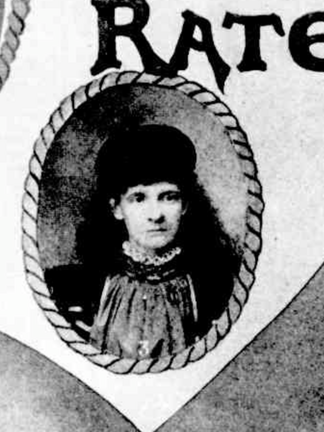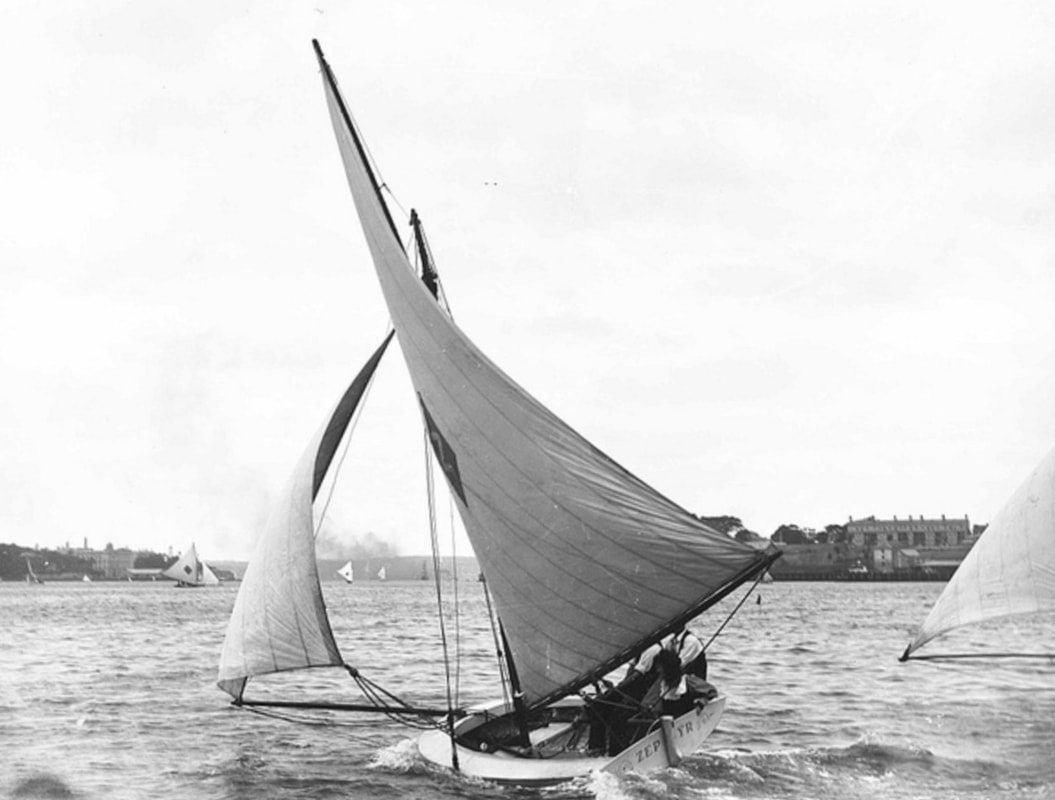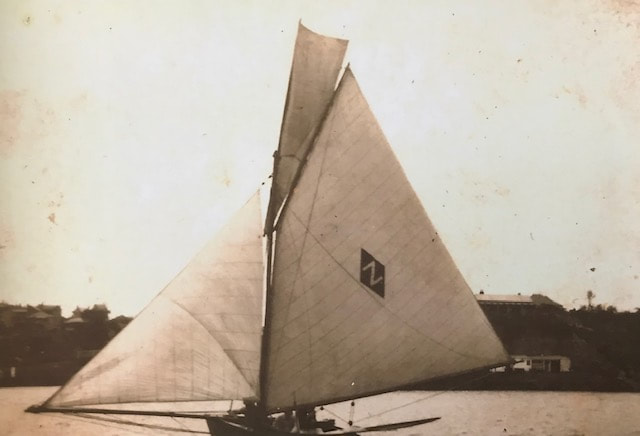The Eight-footers first appeared as a class at the Balmain Regatta* of 1886 in a race for youths under 18. They were canvas boats, that is the hulls were built from canvas stretched over a light framework of ribs and planks that didn't quite meet (see The Open Boat pp30-34). At least some of them were not decked and had sprit rigs. At some stage in the 1890's they began to be built batten-seamed carvel and adopted gaff rig. They were never very numerous, the biggest reported fleet I could find was 11 boats. They had almost died out by 1903 with only three boats turning up for the Championship, but in the 1903-04 season a new Club formed, the Waterview Bay Club which ran 7 races for 8-footers with up to 7 entries. The following two seasons were even busier, with the Sydney Dingy Club (which mainly catered for 14-footers as well as 10-footers) ran 7 races a season in addition to some other races run by the Balmain 8-Footers Club which was probably the renamed Waterview Bay Club. The Sydney Dingy Club ran races for 8-footers in the 1906-07 and 1907-08 seasons but had no more than 5 boats. The writing was on the wall for this Club as its main attraction, the 14-footers had mostly gone to St George (Botany Bay) to sail, the ten-footers were being poached by other clubs including the Balmain Dingy Club and the Lane Cove Club, and the eight-footers were down to a few boats. It appears that 1907-08 was the eight-footers' last season. The Sydney Dingy Club folded completely in early 1912.
Zephyr 1898
Built by the Pritchard family for themselves in 1898, Zephyr was always considered a bit of a freak. The Pritchard family ran a boatshed at the shallow end of Iron Cove at Leichhardt (before moving to Careening Cove in the early years of the 20th Century), and Zephyr was 8 feet long and 8 feet wide! In her first season, 1898-99, she was steered by Irene Pritchard with her two brothers as crew, and in 7 starts for the Port Jackson Dingy Club and the Sydney Dingy Club she had 5 wins, one 2nd and a capsize.
The Pritchards probably sold Zephyr after that because next season they campaigned a new 10-footer Procella which was built on the same lines being 10 feet long and 10 feet wide. Procella however was not as successful. Irene did sail Procella for a while in the 1899-00 season, but I cannot find a report of Irene Pritchard sailing in any races after that season, so she may have decided to quit while she was ahead, but it appears that she married soon afterwards and moved to Western Australia.
Zephyr was unusual in that she appears to be painted white rather than varnished. It is possible that she was canvas-covered, though most canvas boats tended to have the canvas painted to look like timber. She was also reported to be self-bailing, with the water emptying through the centreboard case, but unfortunately there is no indication as to how this worked.
The Pritchards probably sold Zephyr after that because next season they campaigned a new 10-footer Procella which was built on the same lines being 10 feet long and 10 feet wide. Procella however was not as successful. Irene did sail Procella for a while in the 1899-00 season, but I cannot find a report of Irene Pritchard sailing in any races after that season, so she may have decided to quit while she was ahead, but it appears that she married soon afterwards and moved to Western Australia.
Zephyr was unusual in that she appears to be painted white rather than varnished. It is possible that she was canvas-covered, though most canvas boats tended to have the canvas painted to look like timber. She was also reported to be self-bailing, with the water emptying through the centreboard case, but unfortunately there is no indication as to how this worked.

The only photo I can find of Irene Pritchard, from the Town and Country Journal October 21, 1899.
It may have been the Holmes family that bought Zephyr because in the 1899-00 season all four of W., V., P. and L.Holmes are listed as skipper, but also C.Abbott, J.Cronin, F.Shaw and A.Milson appear as skippers. The last is most telling as the skippers for the next few seasons are mostly Milsons, most often P.Milson. The boat continued to perform well, being the most consistent boat in the Sydney Dingy Club in the 1903-04 season under P.Milson, but not Champion but was the Champion of the newly-formed Waterview Bay Club. Another boat Inez seemed to take a greater share of the wins in the next few seasons, but Zephyr was the Champon of the Sydney Dingy Club's last 8-footer season in 1907-08.
The photo below is from the Johnson family collection. They report that Felix Johnson (1897-1978) purchased Zephyr when aged about 16, which makes this photo from about 1913. The Johnson family owned the boatshed on the current site of Pattons Slipway in Careening Cove (opposite the premises of the Pritchard Brothers after they moved from Leichhardt) and probably raced with one of the North Shore clubs such as the North Sydney Dingy Club or the Neutral Bay Club, but I can not yet find any record of this.
It may have been the Holmes family that bought Zephyr because in the 1899-00 season all four of W., V., P. and L.Holmes are listed as skipper, but also C.Abbott, J.Cronin, F.Shaw and A.Milson appear as skippers. The last is most telling as the skippers for the next few seasons are mostly Milsons, most often P.Milson. The boat continued to perform well, being the most consistent boat in the Sydney Dingy Club in the 1903-04 season under P.Milson, but not Champion but was the Champion of the newly-formed Waterview Bay Club. Another boat Inez seemed to take a greater share of the wins in the next few seasons, but Zephyr was the Champon of the Sydney Dingy Club's last 8-footer season in 1907-08.
The photo below is from the Johnson family collection. They report that Felix Johnson (1897-1978) purchased Zephyr when aged about 16, which makes this photo from about 1913. The Johnson family owned the boatshed on the current site of Pattons Slipway in Careening Cove (opposite the premises of the Pritchard Brothers after they moved from Leichhardt) and probably raced with one of the North Shore clubs such as the North Sydney Dingy Club or the Neutral Bay Club, but I can not yet find any record of this.

